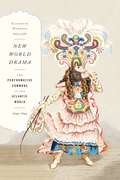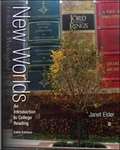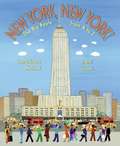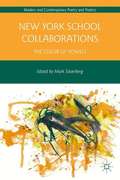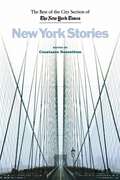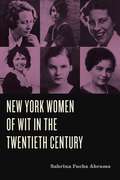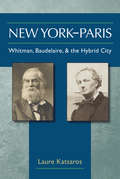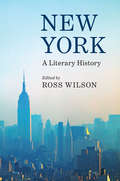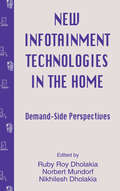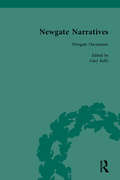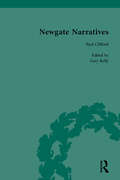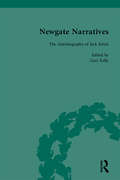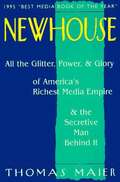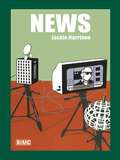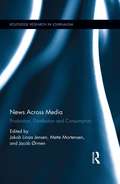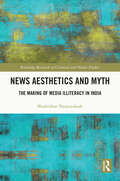- Table View
- List View
New Woman Hybridities: Femininity, Feminism, and International Consumer Culture, 1880–1930 (Routledge Transnational Perspectives on American Literature #Vol. 1)
by Ann Heilmann Margaret BeethamSince the 1970s, the literary and cultural politics of the turn-of-the-century New Woman have received increasing academic attention. Whether she is seen as the emblem of sexual anarchy, an agent of mediation between mass market and modernist cultures, or as a symptom of the consolidation of nineteenth and early twentieth-century political liberation movements, the New Woman represents a site of cultural and socio-political contestation and acts as a marker of modernity. This book explores the diversity of meanings ascribed to the New Woman in the context of cultural debates conducted within and across a wide range of national frameworks including the UK, Canada, North America, Europe, and Japan. The key concept of 'hybridities' is used to elucidate the national and ethnic multiplicity of the 'modern woman' as well as to locate this figure both within international consumer culture and within feminist writing. The book is structured around four key themes. 'Hybridities' examines the instabilities of New Woman identities and discourses in relation to both national/ethnic contexts and the textual parameters of New Woman writings. 'Through the (Periodical) Looking Glass' is concerned with the periodical press and its production and circulation of New Woman images. 'Feminist Counter Cultures?' interrogates feminist efforts to influence and shape this process by mimicking or subverting dominant models of representation and by establishing alternative spaces for the articulation of New Woman subjectivities. 'Race and the New Woman' inspects white New Women's investment in hegemonic racial discourses, looking at the way in which black and non-Western women inserted liberationist discourses into the New Woman debate. This book will be essential reading for advanced students and researchers of American Studies, Women's Studies, and Women's History.
New World Drama: The Performative Commons in the Atlantic World, 1649–1849
by Elizabeth Maddock DillonIn New World Drama, Elizabeth Maddock Dillon turns to the riotous scene of theatre in the eighteenth-century Atlantic world to explore the creation of new publics. Moving from England to the Caribbean to the early United States, she traces the theatrical emergence of a collective body in the colonized New World--one that included indigenous peoples, diasporic Africans, and diasporic Europeans. In the raucous space of the theatre, the contradictions of colonialism loomed large. Foremost among these was the central paradox of modernity: the coexistence of a massive slave economy and a nascent politics of freedom. Audiences in London eagerly watched the royal slave, Oroonoko, tortured on stage, while audiences in Charleston and Kingston were forbidden from watching the same scene. Audiences in Kingston and New York City exuberantly participated in the slaying of Richard III on stage, enacting the rise of the "people," and Native American leaders were enjoined to watch actors in blackface "jump Jim Crow." Dillon argues that the theater served as a "performative commons," staging debates over representation in a political world based on popular sovereignty. Her book is a capacious account of performance, aesthetics, and modernity in the eighteenth-century Atlantic world.
New World Irish
by Jack MorganThe book concerns the new World Irish, tracing the developing profile of the Irish in America from the Famine forward. The studies draw their material from roughly a one-hundred-year arc of Irish presence and relevance in American life and they would serve as American as well as Irish-American studies.
New Worlds: An Introduction to College Reading
by Janet ElderCONNECT READING provides a personalized learning plan for each student, continually developed and refined as students achieve mastery. Each student plan is created through an individualized diagnostic that evaluates skills from 7th-grade level through college-readiness, for second-language learners, international students, adult students, and traditional high-schoolers. Offered completely online, CONNECT READING can be used in conjunction with NEW WORLDS or OPENING DOORS, which provide a printed experience that teaches critical reading skills through close reading of anthologized chapters from best-selling undergraduate texts in Psychology, Sociology, Business, and more.
New York Coach, Supporting the Standards: Target: Reading Comprehension
by Triumph LearningImprove your reading comprehension skills and word recognition with stories, poetry and other selections of exciting reading.
New York Fictions: Modernity, Postmodernism, The New Modern (Longman Studies In Twentieth Century Literature)
by Peter BrookerIn this original study, Peter Brooker takes issue with the simplified opposition of postmodernism to modernism in accounts of the modern period. Instead, he follows the course of modernity in the spectacular example of New York, to reveal the complexities of both modernist and postmodern responses to the city. Brooker's study refers us to the fiction of Doctorow, Don DeLillo and Toni Morrison and especially to the new urban `ethnic' writing. Here the voice of creative dissent and cultural hybridity expresses the best in a tradition of Amerian newness; this Peter Brooker calls the `new modern'. The text is an important contribution to contemporary debates on modernism and postmodernism, providing a thorough interdisciplinary study of new American writing within the socio-economic context of New York City and will be of great interest to students of American Studies, Cultural Studies and Literature.
New York New York: The Big Apple From A To Z
by Laura KraussA sneak peek at the important landmarks of New York.
New York Performance Assessment Grade 9
by Houghton Mifflin HarcourtStudent and teacher resources implement a three-step approach--Analyze the Model, Practice the Task, and Perform the Task--building the high-level skills students need to succeed.
New York School Collaborations
by Mark SilverbergRanging from conceptual theater to visual poetry the New York School explored the possibilities of collaboration like no other group of American poets. New York School Collaborations gathers essays from a diverse group of scholars on the alliances and artistic co-productions of New York School poets, painters, musicians, and film-makers.
New York Stories: The Best of the City Section of the New York Times
by Constance RosenblumThese forty essays from the New York Times&’ City section tell &“stories of human life in all its quirky richness&” (The Boston Globe). Featuring a cast of stellar writers, this collection brings some of the best essays from the City section to readers beyond the five boroughs. New York Stories profiles people like sixteen-year-old Barbara Ott, who surfs the waters off Rockaway in Queens, and Sonny Payne, the beloved panhandler of the F train. Other essays explore memorable places, from the Greenwich Village townhouse blown up by radical activists in the 1970s to a basketball court that serves as the heart of its Downtown neighborhood. The forty essays collected here reflect an intimate understanding of the city, one that goes beyond the headlines. The result is a passionate, well-written portrait of a legendary and ever-evolving place. Contributors include: Andre Aciman, Thomas Beller, Laura Shaine Cunningham, Jim Dwyer, Jill Eisenstadt, Vivian Gornick, Chuck Klosterman, Robert Lipsyte, Phillip Lopate, Jan Morris, Richard Price, Joe Queenan, Suzanne Vega, Meg Wolitzer, and more &“Unassuming, elegant dispatches, suffused with a wise but unsentimental affection.&”—The New Yorker &“All of the pieces are engrossing . . . This is both an excellent addition to New York history and a pleasure for casual browsing.&” ―Publishers Weekly
New York Women of Wit in the Twentieth Century (Humor in America)
by Sabrina Fuchs AbramsSeen as too smart, too sassy, too sexy, and too strident, female humorists have been resisted and overlooked. New York Women of Wit in the Twentieth Century corrects this tendency, focusing on the foremothers of women’s humor in modern America, who used satire, irony, and wit as indirect forms of social protest.This book focuses on the women who stood on the periphery of predominantly male New York intellectual circles in the twentieth century. Sabrina Fuchs Abrams argues that the advent of modernism, the women’s suffrage movement, the emergence of the New Woman and the New Negro Woman, and the growth of urban centers in the 1920s and ’30s gave rise to a new voice of women’s humor, one that was at once defiant and conflicted in defining female identity and the underlying assumptions about gender roles in American society. Her study gives special attention to the contributions of the satirists Edna St. Vincent Millay (pseudonym Nancy Boyd), Tess Slesinger, Dorothy Parker, Jessie Redmon Fauset, Dawn Powell, and Mary McCarthy.Grounded in theories of humor, feminist and critical race theory, and urban studies, this book will find an audience among scholars and students interested in women writers, feminist humor, modern American literature, and African American studies.
New York-Paris: Whitman, Baudelaire, and the Hybrid City
by Laure KatsarosAs New York and Paris began to modernize, new modes of entertainment, such as panoramas, dioramas, and photography, seemed poised to take the place of the more complex forms of literary expression. Dioramas and photography were invented in Paris but soon spread to America, forming part of an increasingly universal idiom of the spectacle. This brave new world of technologically advanced but crudely mimetic spectacles haunts both Whitman's vision of New York and Baudelaire's view of Paris. In New York-Paris, Katsaros explores the images of the mid-nineteenth-century city in the poetry of both Whitman and Baudelaire and seeks to demonstrate that, by projecting an image of the other's city onto his own, each poet tried to resist the apparently irresistible forward momentum of modernity rather than create a paradigmatically happy mixture of "high" and "low" culture.
New York: A Literary History (Routledge Studies In First World War History Ser.)
by Ross WilsonNew York City's streets, parks, museums, architecture, and its people appear in an array of literary works published from New York's earliest settlement to the present day. The exploration of the city as both a symbol and as a reality has formed the basis of New York's literature. Using the themes of adaptation, innovation, identity, and hope, this history explores novels, poetry, periodicals, and newspapers to examine how New York's literature can be understood through the notion of movement. From the periodicals of the nineteenth century, the Arabic writers of the city in the early twentieth century, the literature of homelessness, childhood, and the spaces of tragedy and resilience within the metropolis, this diverse assessment opens up new areas of research within urban literature. It provides an innovative examination of how writing has shaped the lives of New Yorkers and how writing about the city has shaped the modern world.
New and Selected Poems, Volume One
by Mary OliverWhen New and Selected Poems, Volume One was originally published in 1992, Mary Oliver was awarded the National Book Award. In the fourteen years since its initial appearance it has become one of the best-selling volumes of poetry in the country. This collection features thirty poems published only in this volume as well as selections from the poet's first eight books.<P><P> Mary Oliver's perceptive, brilliantly crafted poems about the natural landscape and the fundamental questions of life and death have won high praise from critics and readers alike. "Do you love this world?" she interrupts a poem about peonies to ask the reader. "Do you cherish your humble and silky life?" She makes us see the extraordinary in our everyday lives, how something as common as light can be "an invitation/to happiness,/and that happiness,/when it's done right,/is a kind of holiness,/palpable and redemptive." She illuminates how a near miss with an alligator can be the catalyst for seeing the world "as if for the second time/the way it really is." Oliver's passionate demonstrations of delight are powerful reminders of the bond between every individual, all living things, and the natural world.<P> Winner of the National Book Award
New infotainment Technologies in the Home: Demand-side Perspectives (Routledge Communication Series)
by Ruby Roy Dholakia Nikhilesh Dholakia Norbert MundorfAs the "information superhighway" moves into the home through interactive media, enhanced telecom services, and hybrid appliances, interest continually grows in how consumers adopt and use Information Technology (IT), the strategies IT marketers use to reach consumers, and the public policies that help and protect consumers. USE COPY FROM THIS POINT ON FOR GENERAL CATALOGS... This book presents a unique collection of papers dealing with the demand side issues of new information technologies in the home. The contributors are from business, academia, and the public policy sector and represent many disciplines including communication, marketing, economics, psychology, engineering, and information systems. This book provides one of the best introductions to complex issues such as: * business forces that will shape "Home IT" of the future; * industry structure of the future "Infotainment" mega-business; * factors affecting consumer adoption and use of IT; * international differences in the management of the IT sector; and * public policies that will shape the deployment and use of IT.
Newark: A History of Race, Rights, and Riots in America
by Kevin MumfordNewark's volatile past is infamous. The city has become synonymous with the Black Power movement and urban crisis. Its history reveals a vibrant and contentious political culture punctuated by traditional civic pride and an understudied tradition of protest in the black community. Newark charts this important city's place in the nation, from its founding in 1666 by a dissident Puritan as a refuge from intolerance, through the days of Jim Crow and World War II civil rights activism, to the height of postwar integration and the election of its first black mayor. In this broad and balanced history of Newark, Kevin Mumford applies the concept of the public sphere to the problem of race relations, demonstrating how political ideas and print culture were instrumental in shaping African American consciousness. He draws on both public and personal archives, interpreting official documents--such as newspapers, commission testimony, and government records--alongside interviews, political flyers, meeting minutes, and rare photos. From the migration out of the South to the rise of public housing and ethnic conflict, Newark explains the impact of African Americans on the reconstruction of American cities in the twentieth century.
Newgate Narratives Vol 1
by Gary KellyPresents a representative body of Romantic and early Victorian crime literature. This work contains ephemeral material ranging from gallows broadsides to reports into prison conditions. It is suitable for those studying Literature, Romantic and Victorian popular culture, Dickens Studies and the History of Criminology.
Newgate Narratives Vol 2
by Gary KellyPresents a representative body of Romantic and early Victorian crime literature. This work contains ephemeral material ranging from gallows broadsides to reports into prison conditions. It is suitable for those studying Literature, Romantic and Victorian popular culture, Dickens Studies and the History of Criminology.
Newgate Narratives Vol 3
by Gary KellyPresents a representative body of Romantic and early Victorian crime literature. This work contains ephemeral material ranging from gallows broadsides to reports into prison conditions. It is suitable for those studying Literature, Romantic and Victorian popular culture, Dickens Studies and the History of Criminology.
Newgate Narratives Vol 4
by Gary KellyPresents a representative body of Romantic and early Victorian crime literature. This work contains ephemeral material ranging from gallows broadsides to reports into prison conditions. It is suitable for those studying Literature, Romantic and Victorian popular culture, Dickens Studies and the History of Criminology.
Newgate Narratives Vol 5
by Gary KellyPresents a representative body of Romantic and early Victorian crime literature. This work contains ephemeral material ranging from gallows broadsides to reports into prison conditions. It is suitable for those studying Literature, Romantic and Victorian popular culture, Dickens Studies and the History of Criminology.
Newhouse: All the Glitter, Power, and Glory of America's Richest Media Empire and the Secretive Man Behind It
by Thomas MaierThis book explores the history of the Newhouse family-a family that went from near poverty to amassing a media fortune of 13 billion. The Newhouse media empire includes influential magazines, book publishing houses, newspapers, and cable oulets. The book chronicles the Newhouse family story in a facinating must read style.
News
by Jackie HarrisonFrom an author highly knowledgeable in the field, News is a handy and accessible guide that examines the history of news, both as newspapers and radio, and as entertainment and information, and introduces students to the key concepts and issues that surround the news. Using up-to-date case examples such as the Hutton Report and embedded journalists, from across a range of media including print, radio, television and the internet, Jackie Harrison explains the different theoretical approaches that have been used to study the news, as well as providing an accessible introduction to how news is produced and regulated, what counts as news, and how it is selected and presented. Topics covered include: introduction to the concept of news the growth and development of news technology, concentration and competition balancing freedom and responisibility regulatory control of the news making the news. Written in a clear and lively style, News is the ideal introductory book for students of media, communication and journalism.
News Across Media: Production, Distribution and Consumption (Routledge Research in Journalism)
by Mette Mortensen Jakob Linaa Jensen Jacob ØrmenNews production, distribution and consumption are in rapidly changing due to the rise of new media. This book examines how these processes become more and more interrelated through logics of dissemination, sharing and co-production. These changes have the potential to affect the criteria of newsworthiness as well as existing power structures and relations within the fields of journalism and agenda setting. The book discusses changing logics of production, from citizens’ as well as journalists’ perspectives, examines distribution and sharing as a link between but also an intrinsic part of production and consumption, and addresses the changing logics of consumption. Contributors place such changes in a historical perspective and outline challenges and future research agendas.
News Aesthetics and Myth: The Making of Media Illiteracy in India (Routledge Research in Cultural and Media Studies)
by Shashidhar NanjundaiahThis book considers the presence of media illiteracy in a world in which we are supposedly consumed by media, live a media life, in a media ecosystem, surrounded by mediated communication.Unpacking this paradoxical situation, the author proposes that before venturing into media literacy, we must first understand the workings of how mystification occurs. Departing from the idea that aesthetics work on an agreed set of principles between art and society, the author applies this ideology of aesthetics to news-based narration. Using empirical cases from India, the author proposes demystification as a possible methodology to approach media illiteracy and recommends completely transformed media literacy programs that deliver to communities, drawing from the construct of critical pedagogy. The book offers the possibilities for a collectivistic, non-Western, postcolonialist model of learning by using the very collective and hierarchical identities of societies that must be critiqued.This vital and innovative book will be an important resource for scholars and students in the areas of media literacy and critical media literacy, media education, journalism, mass communication, aesthetics and media technology.

